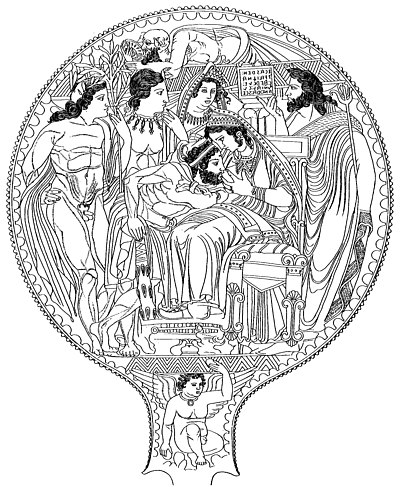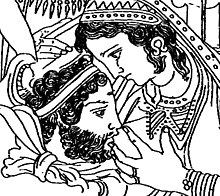Bronze mirror from Volterra
The bronze mirror of Volterra is an Etruscan artifact from the late 4th century BC. BC and is now in the National Archaeological Museum of Florence . The mirror was found in Volterra ( Etruscan Velathri ) and shows Uni ( Hera ), the highest goddess of the Etruscans, suckling Hercle ( Heracles ). The bronze mirror is an example of how the Etruscans modified and reinterpreted Greek myths in the visual arts .
description
The mirror is made of bronze , an alloy of copper and tin that was widely used in ancient times. The diameter of the almost circular disc is 29.5 cm. The front was polished, the depicted engraving is on the back. The mirror has a base to which a handle was probably attached. Bronze mirrors of this type were made between the 6th and 3rd centuries BC. Made with a main production time in the 4th century BC. Chr.
In the mirror you can see a woman breastfeeding a grown, bearded man. Based on the inscription, these two people can be identified as Uni, the highest goddess of the Etruscans, and Hercle, whom the Etruscans had adopted from Greek mythology . Uni sits on an ornate throne. Your feet rest on a small stool. She is dressed in an ankle-length dress and wearing on his head a diadem . The back and head are covered with a veil or cape . Hercle has bent the left leg in front of the straight leg and rests on a club with his right hand . He wears a loincloth, a forehead band, and a cloak tied around his neck.
Several people are present as witnesses to the scene. On the far left is a naked man with a cloak around his left shoulder and right forearm from behind. In his left hand he carries a long branch of laurel and a laurel wreath on his head . It could therefore be Apulu ( Apollon ), a deity borrowed from the Greek world of gods.
Next to Apulu is another apparently unclothed person who has not yet been identified. It should also be a deity, since the heroic nudity symbolizes divinity. In the center backwards you can see a woman with a diadem and veil. The goddess Hebe could be represented, a daughter of Hera, who was given to Heracles as wife after his elevation to Olympus . She seems to be putting a protective cloak over Uni with her right hand.
On the right side you can see a bearded man whose body is covered with a long cape with a braid . In his left hand he holds a lance or a trident . Therefore, it could be Nethuns ( Neptune ), an Etruscan water god who corresponds to the Greek Poseidon . The prevailing opinion, however, assumes that Tinia , the supreme god of the Etruscans and husband of Uni, is represented. With his right hand he directs the gaze of everyone present except Uni and Hercle to an inscription that rests on a pillar carved in stone.
The entire picture scene is delimited at the top and bottom by strips with various zigzag patterns . The resulting fields are also filled with motifs. In the upper segment of the circle, a bare-chested satyr looks into a bowl. A naked male winged creature appears in the lower field, lifting an egg with his left hand . It is holding another egg in its right hand.
inscription
The characters are written from right to left according to the Etruscan writing habits, whereby the individual words are separated from one another by colons, but can extend over the line break. The inscription reads:
- ECA SREN TVA ICHNAC HERCLE UNIAL CLAN THRA SCE
ECA SREN stands for “this picture”, TVA could be a verb in the third person singular and mean “shows”. ICHNAC corresponds to "how". HERCLE is in the nominative and UNIAL is the genitive of UNI. CLAN means son. THRA could be a form of “suck” and SCE could stand for “milk”. Occasionally, THRASCE is read as a word meaning "he has sucked". Overall, the reading results:
- This picture shows how Hercle, Uni's son, suckled (milk).
The Greek Heracles actually sucked on Hera's breast , but when he was a baby and not as a grown man.
Inscriptions on Etruscan works of art were not only used for description, but also gave the representation a sacred character. Writing itself was a ritual act with magical effects.
interpretation
In Greek mythology, Zeus fathered Heracles with Alcmene, which is why Hera, out of jealousy, became his lifelong persecutor. Alkmene abandoned the infant for fear of Hera's hatred. Athena found him and brought him to Hera, who Herakles did not recognize and nursed him out of pity. With the divine milk, Heracles received supernatural powers, but not immortality.
In his childhood, Heracles had to survive an assassination attempt by Hera. Later she maddened him, so that he slew his wife and children. When Heracles was dying in agony, he was raised among the Olympian gods and gained immortality. Hera soothed the torments she had suffered so that she adopted Heracles and married her daughter Hebe, the goddess of youth.
In Etruscan mythology, Hera's hatred of Heracles is discussed on only a few monuments. It clearly outweighs the portrayal of a friendly and even loving relationship between Uni and Hercle, which corresponds better to the theophoric meaning of the name Heracles : Glory of Hera . In the scenes depicted on vases or mirrors, Hera is often protected or saved by Heracles.

The motif of the suckling of an adult Heracles can only be found on Italian and Etruscan artifacts and appears on four Etruscan bronze mirrors and a southern Italian vase. Suckling is evidently to be understood as a ritual act through which Heracles is adopted by Hera on the one hand and prepared for entering Olympus on the other hand, since, according to the Etruscan view, only milk gives him immortality. The apotheosis of Heracles is a Greek myth , but to associate him with suckling is an Italian or Etruscan peculiarity.
Since Hercle will now become a god through the ritual and is therefore worthy of the family of Tinia and Uni, the female person in the background will be his future bride Hebe, the daughter of Uni and Tinia. The representation shows not only the adoption and apotheosis of Hercle, but also the ceremony of marriage, of which the university is the patroness. By suckling, the goddess transforms the hero and gives him happiness and immortality.
The satyr evidently practices leconomanty , a form of divination in which the future is predicted using water in a bowl. Perhaps the satyr in the bowl sees the impending apotheosis of Hercle.
literature
- Giuliano Bonfante , Larissa Bonfante : The Etruscan Language. An Introduction. 2nd Edition. Manchester University Press, Manchester / New York 2002, ISBN 0719055407 , p. 155.
- Larissa Bonfante: Nursing Mothers in Classical Art. In: Ann Olga Koloski-Ostrow, Claire L. Lyons (eds.): Naked Truths. Women, Sexuality, and Gender in Classical Art and Archeology. Routledge, London et al. 1997, ISBN 0415159954 , pp. 174-196, here pp. 180-181.
- Larissa Bonfante: Etruscan mirrors and the grave. In: Marie-Laurence Haack (ed.): L'écriture et l'espace de la mort. Epigraphie et nécropoles à l'époque préromaine . Publications de l'École française de Rome, Rome 2016, ISBN 9782728310951 , pp. 284–308, here pp. 298–299, doi : 10.4000 / books.efr.2741 .
- Nancy Thomson de Grummond (Ed.): A Guide to Etruscan mirrors. Archaeological News, Tallahassee FL 1982, ISBN 0943254000 , p. 76.
- Nancy Thomson de Grummond: Etruscan Myth, Sacred History, and Legend. University of Pennsylvania, Philadelphia PA 2006, ISBN 9781931707862 , pp. 82-84.
- Ambros Josef Pfiffig : Heracles in the imagery of the Etruscan mirror. Redrawings by Johannes Thomas Ambrózy. Academic printing and Verlagsanstalt, Graz 1980, ISBN 3201011428 , pp. 14–15.



